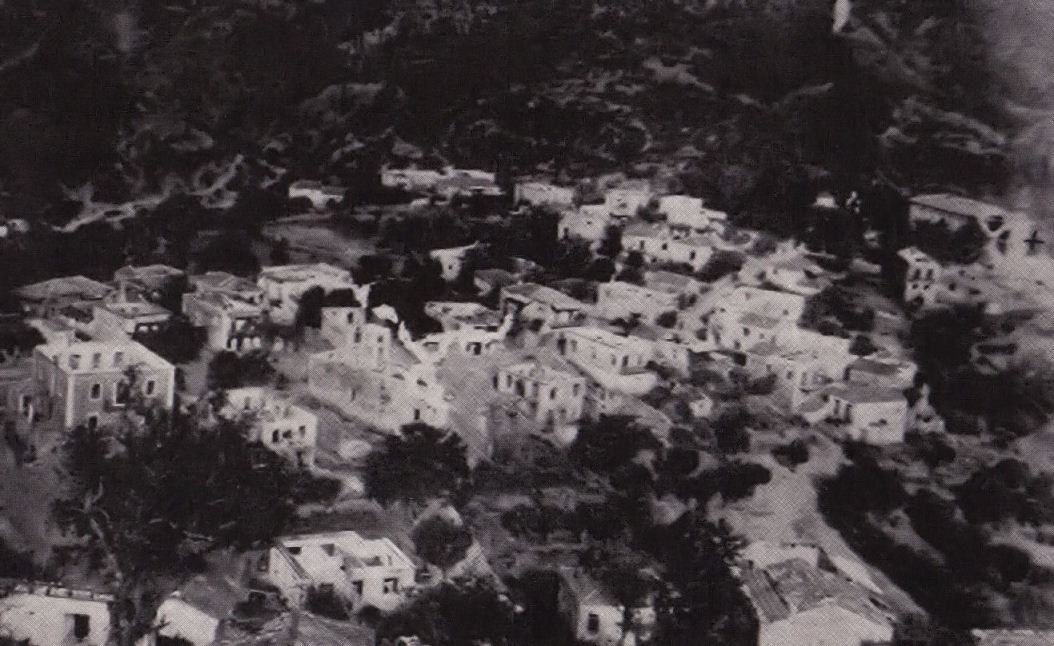2nd World War (1942-1944)
During the 2nd World War, Karyes' residents participate in the struggle against the German invaders, unfortunately without avoiding serious consequences and loss of lives. The local residents for their safety guarded the entrances of the settlement and built safe-huts on the mountain, in which they often escaped to save their lives. In the village, a body of the National Liberation Front remained active, which was established in 1942 under the command of Reservist Lieutenant Paraskevas Leventakis. This body organized several sabotages to the German troops, but unfortunately the German conquerors retaliated against the local residents.
The First Episode
The first serious incident occurred in December 18th, 1942. That rainy and cold day after rebel ambush against a German convoy, the local residents feared retaliation and moved around on the slopes, leaving behind the elderly, women and children. The entry and stay of the Italian troops in the village lasted several days, trying to hurt the morale of the people. Because those who had taken refuge on the mountain had not returned, the Italians kept terrorizing the remaining residents with food looting, arrests, interrogations, shooting blindly, torture and burning of houses. Those who returned, under threat of killing their relatives, had the same fate and worse. All these lasted for days and the inhabitants suffered enough hardships.
The Great Retribution
The biggest retribution yet happened in September 19th, 1943. The Germans arrived quietly at 5 a.m. at the entrance of the village, excluding methodically all crossings to and from it, trapping thus unsuspecting residents. A voice from the hill of St. Ioannis' church sounded along with the bell, "the Germans are coming by cars", suddenly waking up the residents from their sleep. But soon, they found out that it was too late to escape to the mountain. All crossings were already blocked for them. In the twilight followed panic, confusion, trembling and then started flares, bursts of machine guns, explosions from grenades and screams. On that morning ten (10) people were killed from the age of 12 to 60, and four (4) were wounded, of which two (2) died a few days later. Then followed the looting of houses, the marking those destined for burning and the concentration of residents for inquisition. Germans burned and blew up houses and arrested thirty-one (31) people as hostages. Twenty one (21) from a list on paper and nine (9) from the pile of collected. The redemption of suffering ended with the arrival of Alexander Persson, who was by that time the representative of the International Red Cross. The evening of the same day came with the search of the dead, the mourning of relatives and the funerals. Twenty-one (21) of the hostages had been sent to Averof prison in Athens. Then six (6) were released, one (1) (K. Theodorakakis) moved in Germany's forced labor camp and thirteen (13) in Thessaloniki's Pavlos Melas military camp, which they were released later in March 1944.
On 26th of November 1943, the German applying retaliation on civilians for an attack by the rebels in Monodentri, executed in the same position 118 of the elite people of Laconia, who had nothing to do with the attack. Among them the finest and beloved man of Arachova, doctor Christos Ef. Karvounis. He had the chance to escape the killing, as he was recognized by the head officer of the Germans, but refused this option and he died like a hero.
The burning of Arachova (Karyes) by the German troops (March 14-15.1944)
At 11 am, German troops entered the village, set up outposts and began looting. The burning of houses started at noon, beginning with the bombing of the school building with a mine, which tore across the western corner of the building. The whole underside of the village filled with smoke and dust by this explosion. The women of the village made great sacrifices that day as they hid in the gardens and got into the burning houses trying to save them. They put out the flames that threatened their homes and lit new ones by burning old clothes on sheets of metal, in an attempt to fool the Germans. In this way about 40 houses survived the first day. By the end of the first day, the record showed 200 houses burned down and 8 people dead.
The next day, 100 of the houses that had still roofs were burning and a elder man was killed. Then they blew up the clock on the hill of St. Ioannis using a mine, which caused iron and cement pieces to reach the spring of Sakalis at the lower site of the village. Those who had managed to escape on the mountain watched dumbfounded from a high spot these two days explosions, fire and disasters, mute and unable to react. Their return was accompanied by the sad spectacle of remaining burnt stone walls and dead bodies of relatives and friends. Once more funerals and mourning had followed.
The lower settlement of Karyes destroyed after the "burn of Arachova" by the German troops
The Last Struggle
A further struggle of the village followed with the last major raid of German troops on Parnon Mountain from 23th of June to 8th of July 1944, terrorizing residents of the 15 villages that were on their way. Once again terrorism and shootings prevailed, forcing local residents to the surrounding mountains and caused the death of fourteen (14) more people from the village.
In September 1944 began the withdrawal of German troops from Laconia and the final release of Arachova (Karyes).
Source: Κ.Μ. Pitsios (1948), Karyaí (Aráchova) Lakedaímonos, Historical, Cultural Study
Previous: Midwar Era |
Next: Other Historic Elements |













